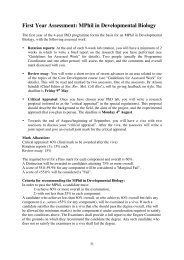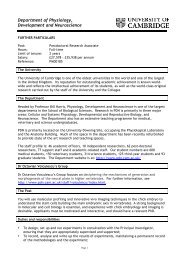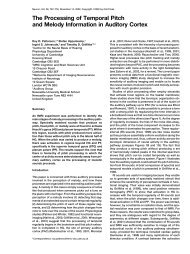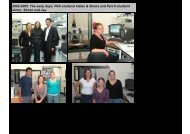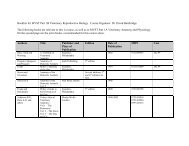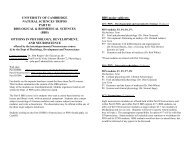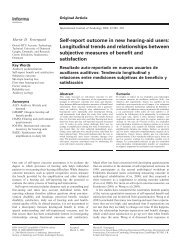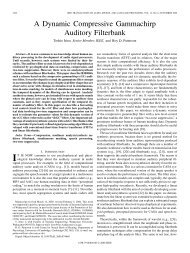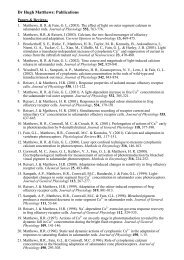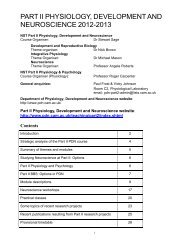FRIDAY MORNING, 20 MAY 2005 REGENCY E, 8:30 A.M. TO 12:00 ...
FRIDAY MORNING, 20 MAY 2005 REGENCY E, 8:30 A.M. TO 12:00 ...
FRIDAY MORNING, 20 MAY 2005 REGENCY E, 8:30 A.M. TO 12:00 ...
Create successful ePaper yourself
Turn your PDF publications into a flip-book with our unique Google optimized e-Paper software.
plained from Outer-Hair-Cell OHC activity. At low levels, OHC activity<br />
increased frequency-selectivity by amplifying the signal in the spectral<br />
gap, improving the signal-to-noise ratio SNR. Relative to the broad passive<br />
cochlear filter, OHC activity decreased with rising signal levels. In<br />
consequence, SNRs decreased and detection deteriorated. Similarly, decreasing<br />
OHC activity may explain the observed level dependence of detection<br />
thresholds in temporal gaps. At low and high intensities, signal and<br />
noise were equally amplified. Detection was best at intermediate levels<br />
when the low-level signal in the temporal gap was amplified more than the<br />
high-level noise. All effects are modeled using a one-parameter time window<br />
with decaying-exponential shape preceded by a simplified dualresonance<br />
non-linear DRNL filter. The filter contains two parallel, oneparameter,<br />
Rounded Exponential filters: a broad filter representing passive<br />
cochlear filtering and a narrow one, combined with a level-dependent<br />
amplifier, representing OHC activity. From estimated filter and timewindow<br />
widths and OHC amplification, compression curves are derived.<br />
Additionally, results for hearing-impaired listeners will be presented.<br />
5aPP14. Speech understanding in noise: Contributions of compressive<br />
nonlinearities in the basilar-membrane response. Amy R. Horwitz,<br />
Jayne B. Ahlstrom, and Judy R. Dubno Dept. of Otolaryngol.-HNS,<br />
Medical Univ. of South Carolina, 135 Rutledge Ave., P.O. Box 250550,<br />
Charleston, SC 29425, horwitar@musc.edu<br />
The contribution of compressive nonlinearities in the basilarmembrane<br />
response was assessed by measuring speech recognition in<br />
noise as a function of noise level and growth of masking for tones. Consonant<br />
recognition was measured in interrupted noise at overall masker<br />
levels of 47–77 dB SPL. Additionally, thresholds for a 10-ms, 2.0-kHz<br />
tone were measured in a masker ranging in level from 40 to 85 dB SPL<br />
and centered at 1 kHz. Subjects were younger and older adults with normal<br />
hearing. With speech at a constant level and the masker level varying,<br />
it was hypothesized that the response of the basilar membrane to the<br />
masker would be linear at lower levels and compressed at medium to<br />
higher levels, resulting in less effective masking at higher masker levels.<br />
Consistent with the hypothesis, differences between observed and predicted<br />
consonant-recognition scores, determined using AI calculations,<br />
varied as a function of masker level, especially for younger subjects. At<br />
lower masker levels, observed scores declined as predicted as masker level<br />
increased; with further increases in masker level, scores declined less than<br />
predicted. For tonal growth-of-masking functions, breakpoints were correlated<br />
with quiet thresholds: both were significantly higher for older than<br />
younger subjects. Work supported by NIH/NIDCD.<br />
5aPP15. Psychometric-function slopes for forward-masked tones in<br />
listeners with cochlear hearing loss. Kim S. Schairer, Jessica<br />
Messersmith, and Walt Jesteadt Boys Town Natl. Res. Hospital, 555<br />
North <strong>30</strong>th St., Omaha, NE 68131<br />
Slopes of psychometric functions PF for forward-masked tones in<br />
normal-hearing NH listeners decrease as a function of signal threshold in<br />
both on- and off-frequency masker conditions. This result is attributed to<br />
nonlinear cochlear response growth, and has been used to demonstrate<br />
comparable compression at 4<strong>00</strong>0 and 250 Hz. The current study further<br />
tested the hypothesis that the slope effect is due to nonlinearity. In hearingimpaired<br />
HI listeners who presumably lack cochlear nonlinearity, PF<br />
slopes should remain steep across signal threshold levels. Four NH and six<br />
HI listeners with a range of hearing thresholds were tested in on- and<br />
off-frequency masker conditions, with signals of 4<strong>00</strong>0 and 250 Hz.<br />
Otoacoustic emissions were measured to verify absent or decreased cochlear<br />
nonlinearity in the HI listeners. In general, PF slopes were steeper<br />
for the HI than NH listeners. One subject had normal hearing at 250 Hz,<br />
and hearing loss at 4<strong>00</strong>0 Hz. Her PF slopes were comparable to the mean<br />
slopes across NH subjects in the 250-Hz signal conditions, but were elevated<br />
in comparison to the NH subjects in the 4<strong>00</strong>0-Hz conditions. These<br />
results are consistent with predictions from a model of forward masking<br />
that incorporates cochlear nonlinearity as one of its stages.<br />
5aPP16. Masker variability effects in backward-masked frequency<br />
discrimination. Blas Espinoza-Varas and Hyunsook Jang Commun.<br />
Sci. and Disord., Univ. Oklahoma Health Sci. Ctr., Oklahoma City, OK<br />
73190<br />
Masker variability effects have been studied mostly in detection tasks<br />
with simultaneous maskers; this paper reports variability effects in a frequency<br />
discrimination threshold FDT paradigm with backward maskers.<br />
FDTs for sinusoidal targets were measured unmasked or in isolation and<br />
in two backward-masked conditions: one included within-trial masker frequency<br />
variability, the other did not. The 15<strong>00</strong>-Hz, 40- or 80-ms targets,<br />
and 5<strong>00</strong>-, 15<strong>00</strong>-, or 25<strong>00</strong>-Hz, 80-ms maskers were presented at 70-dB SPL<br />
with a <strong>20</strong>-ms ISI. A standard and two comparisons were displayed, respectively,<br />
in the 1st, 2nd, and 3rd observation interval of a 3I/2AFC task. One<br />
comparison, chosen randomly with 0.5 probability, contained an increment<br />
in target frequency as specified by an adaptive rule that estimated 71<br />
percent-correct FDTs. Identical increments in masker frequency were<br />
added to both comparisons in within-trial variability conditions, but not in<br />
conditions without variability. In all conditions, the task was to determine<br />
which comparison contained the target frequency increment. Masked novariability<br />
FDTs were higher than unmasked FDTs, but training nullified<br />
this effect. Masker variability induced greater FDT elevations with 40-<br />
than with 80-ms targets, and in conditions having the same rather than<br />
different target-masker frequencies. Prolonged training nullified all masker<br />
variability effects.<br />
5aPP17. Hearing relative phases for two harmonic components. D.<br />
Timothy Ives, Roy D. Patterson C.N.B.H., Physio. Dept., Univ. of<br />
Cambridge, Downing St., Cambridge, CB2 3EG, UK, tim.ives@<br />
mrc-cbu.cam.ac.uk, and H. Martin Reimann Univ. of Berne, <strong>30</strong><strong>12</strong><br />
Berne, Switzerland<br />
There is a new wavelet model of basilar membrane motion which<br />
predicts that existing roex and gammatone filterbanks underestimate the<br />
interaction of harmonically related components in complex tones. This<br />
interaction appears as a modulation of the basilar membrane motion associated<br />
with a higher harmonic by the presence of a lower harmonic; the<br />
period of the modulation is that of the difference frequency, or the fundamental<br />
of the implied harmonic series. The modulation depth is largest for<br />
stimuli whose spectra have a similar energy distribution as natural sounds:<br />
a high frequency roll-off of about <strong>12</strong>-dB per octave. The strength of the<br />
modulation frequency is dependent on the relative phase of the components,<br />
which predicts that listeners will be able to hear a relative phase<br />
change. A series of experiments were undertaken to determine the threshold<br />
for a change in the relative phase of the components. The results of the<br />
experiments show that a change in the relative phase is detectable for<br />
components that are generally believed to be resolved on the basilar membrane<br />
and therefore should not interact. Work supported by the U.K.<br />
Medical Research Council G990<strong>12</strong>57.<br />
5aPP18. The fading of auditory memory. Liang Li, Juan Huang,<br />
Lingzhi Kong, Ying Huang Dept. of Psych., Speech and Hearing Res.<br />
Ctr., Peking Univ., Beijing 1<strong>00</strong>871, China liangli@pku.edu.cn, Xihong<br />
Wu, Jing Chen, Qiang Huang, Yuan Yao Peking Univ., Beijing 1<strong>00</strong>871,<br />
China, James Qi, and Bruce Schneider Univ. of Toronto at Mississauga,<br />
Mississauga, ON, Canada<br />
Due to auditory memory, the auditory system is capable of maintaining<br />
a detailed representation of arbitrary waveforms for a period of time, so<br />
that a broadband noise and its delayed copies can be perceptually fused.<br />
This auditory memory would be critical for perceptually grouping correlated<br />
sounds and segregating uncorrelated sounds in noisy, reverberant<br />
environments. Its fading process over time was investigated in the present<br />
study at the behavioral level, using a break in correlation BIC, a drop of<br />
inter-sound correlation from 1.<strong>00</strong> to 0 and then return to 1.<strong>00</strong> between<br />
two correlated broadband noises. The results show that with the rise of<br />
inter-sound delay from 2 to 10 ms under either headphone-stimulation or<br />
loudspeaker-stimulation conditions, the shortest BIC duration necessary<br />
5a FRI. AM<br />
2599 J. Acoust. Soc. Am., Vol. 117, No. 4, Pt. 2, April <strong>20</strong>05 149th Meeting: Acoustical Society of America 2599



